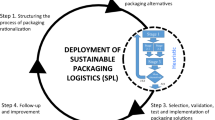Abstract
Product packaging has a huge impact on the efficiency of supply chain activities. In this research, the concept of Design for Assembly (DFA), proved in earlier studies to be effective at improving product manufacturing operations, is applied to the packaging system. We formulate the packaging system as a mathematical model for three different objectives. With respect to the continual rise in attention paid to sustainability, this research adds sustainability as one of the primary objectives. A case study demonstrates that the proposed model can achieve desired results and reveals a level of consistency among the three objectives. In addition to the application of DFA concepts to a packaging system, the contributions of this research lie in the development of a mathematical model (using integer programming and goal programming) for calculating the cost, handling time, and sustainability of the objectives in line with the design needs of the multi-level packaging size from the perspective of a supply chain to provide a range of solutions offering increased options for firms.



Similar content being viewed by others
References
Bogue R (2012) Design for manufacture and assembly: background, capabilities and applications. Assembly Autom 32(2):112–118
Boothroyd G, Alting L (1992) Design for assembly and disassembly. CIRP Ann 41(2):625–636
Carbon Footprint Calculation Platform (2013) Retrieved March 22, 2017, from Carbon Footprint Calculation Platform Web. https://cfp-calculate.tw/cfpc/WebPage/LoginPage.aspx. Accessed 22 Mar 2017
Chan FTS, Chan HK, Choy KL (2006) A systematic approach to manufacturing packaging logistics. Int J Adv Manuf Tech 29(9):1088–1101
Dominic C, Johansson K, Lorentzon A, Olsmats C, Tiliander L, Weström P (2000) Förpackningslogistik, 2nd edn. Packforsk. Kista, Sweden
Apple Environment (2020) Retrieved August 16, 2020, from Apple Environment Web. https://www.apple.com/environment/. Accessed 16 Aug 2020
García-Arca J, Prado-Prado JC, González-Portela Garrido AT (2012) Strategic packaging logistics: A case study from a supply chain perspective. In: Prado-Prado J, García-Arca J (eds) Annals of industrial engineering 2012. Springer, London, p 374p
García-Arca J, González-Portela AT, Prado-Prado JC (2014a) Packaging as source of efficient and sustainable advantages in supply chain management: an analysis of bricks. Intl J Prod Manag Eng 2(1):15–22
García-Arca J, Prado-Prado JC, Gonzalez-Portela Garrido AT (2014b) “Packaging logistics”: promoting sustainable efficiency in supply chains. Int J Phys Distrib Logist Manag 44(4):325–346
Goyal P, Rahman Z, Kazmi AA (2013) Corporate sustainability performance and firm performance research. In: Management Decision
Hellstrom D, Saghir M (2007) Packaging and logistics interactions in retail supply chains. J Packag Technol Sci 20(3):197–216
Hsu W, Fuh YHJ, Zhang Y (1998) Synthesis of design concepts from a design for assembly perspective. Comput Integr Manuf Syst 11(1–2):1–13
Jönson G (2000) Packaging technology for the logistician, 2nd Ed., Lund University
Keeble JJ, Topiol S, Berkeley S (2003) Using indicators to measure sustainability performance at a corporate and project level. J Bus Ethics 44(2–3):149–158
Klevås J (2006) Design for packaging logistics. In: Proceedings Design 2006, 9th International Design Conference, Dubrovnik 2006. Methods and Tools in Design Practice, pp 269–278
Lindh H, Williams H, Olsson A, Wikström F (2016) Elucidating the indirect contributions of packaging to sustainable development: a terminology of packaging functions and features. Packag Technol Sci 29(4):225–246
Lockamy A (1995) A conceptual framework for assessing strategic packaging decisions. Int J Logist Manag 6(1):51–60
Orth UR, Malkewitz K (2008) Holistic package design and consumer brand impressions. J Mark 72(3):64–81
Pålsson H, Finnsgård C, Wänström C (2013) Selection of packaging systems in supply chains from a sustainability perspective: the case of Volvo. Packag Technol Sci 26(5):289–310
Rundh B (2009) Packaging design: creating competitive advantage with product packaging. Brit Food J 111(9):988–1002
Rundh B (2013) Linking packaging to marketing: how packaging is influencing the marketing strategy. Brit Food J 115(11):1547–1563
Samsung Climate Action (2020). Retrieved August 16, 2020, from Samsung Climate Action Web. https://www.samsung.com/levant/aboutsamsung/sustainability/environment/climate-action/. Accessed 16 Aug 2020
Schaltegger S, Wagner M (2006) Integrative management of sustainability performance, measurement and reporting. Int J Account Audit Perform Eval 3(1):1–19
Svanes E, Vold M, Møller H, Pettersen MK, Larsen H, Hanssen OJ (2010) Sustainable packaging design: a holistic methodology for packaging design. Packag Technol Sci 23(3):161–174
Twede D (1992) The process of logistical packaging innovation. J Bus Logist 13(1):69
Zailani S, Shaharudin MR, Govindasamy V, Ismail M, Mahdzar SFAS (2015) The eco-efficiency practices of the sustainable packaging and its effect towards sustainable supply chain performance. In: Technology Management and Emerging Technologies (ISTMET), 2015 International Symposium, pp 448–453
Acknowledgements
The authors would like to thank the Ministry of Science and Technology of Taiwan for financially supporting this research under Contract no. MOST 109-2628-E-007-002-MY3 and MOST 107-2221-E-019-035. This work was also supported by the Advanced Manufacturing and Service Management Research Center (AMSMRC), National Tsing Hua University, Taiwan.
Author information
Authors and Affiliations
Corresponding author
Additional information
Publisher's Note
Springer Nature remains neutral with regard to jurisdictional claims in published maps and institutional affiliations.
Rights and permissions
About this article
Cite this article
Chiu, MC., Chung, WH. & Lin, HH. Applying DFA and goal programming to improve economic efficiency, material handling convenience, and sustainability of a product packaging system. Res Eng Design 32, 157–173 (2021). https://doi.org/10.1007/s00163-020-00355-4
Received:
Revised:
Accepted:
Published:
Issue Date:
DOI: https://doi.org/10.1007/s00163-020-00355-4




